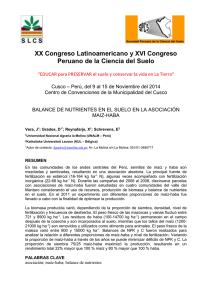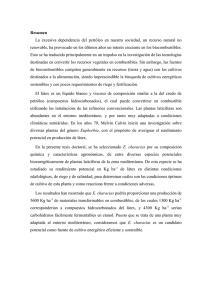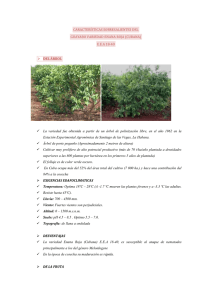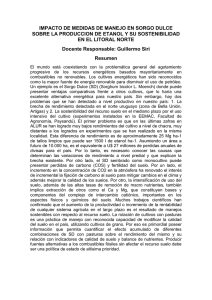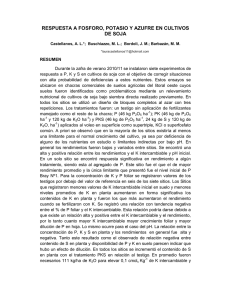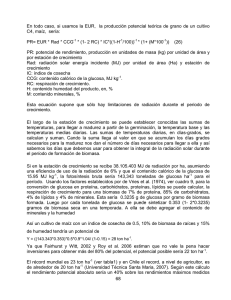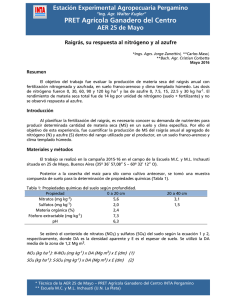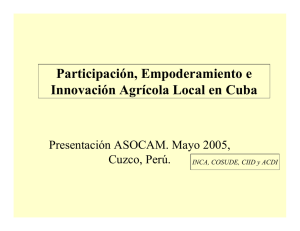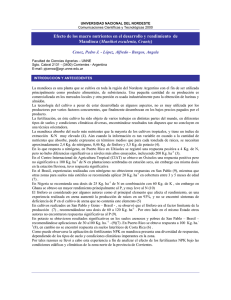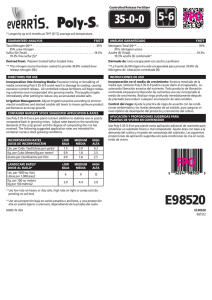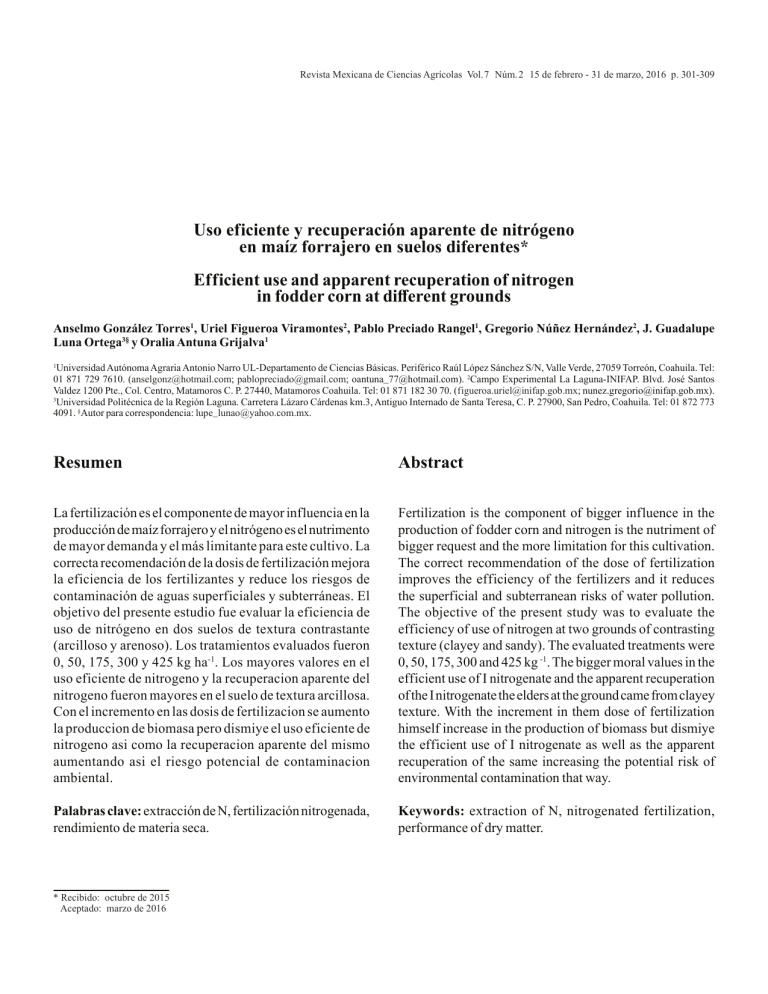
Revista Mexicana de Ciencias Agrícolas Vol.7 Núm.2 15 de febrero - 31 de marzo, 2016 p. 301-309 Uso eficiente y recuperación aparente de nitrógeno en maíz forrajero en suelos diferentes* Efficient use and apparent recuperation of nitrogen in fodder corn at different grounds Anselmo González Torres1, Uriel Figueroa Viramontes2, Pablo Preciado Rangel1, Gregorio Núñez Hernández2, J. Guadalupe Luna Ortega3§ y Oralia Antuna Grijalva1 Universidad Autónoma Agraria Antonio Narro UL-Departamento de Ciencias Básicas. Periférico Raúl López Sánchez S/N, Valle Verde, 27059 Torreón, Coahuila. Tel: 01 871 729 7610. ([email protected]; [email protected]; [email protected]). 2Campo Experimental La Laguna-INIFAP. Blvd. José Santos Valdez 1200 Pte., Col. Centro, Matamoros C. P. 27440, Matamoros Coahuila. Tel: 01 871 182 30 70. ([email protected]; [email protected]). 3 Universidad Politécnica de la Región Laguna. Carretera Lázaro Cárdenas km.3, Antiguo Internado de Santa Teresa, C. P. 27900, San Pedro, Coahuila. Tel: 01 872 773 4091. §Autor para correspondencia: [email protected]. 1 Resumen Abstract La fertilización es el componente de mayor influencia en la producción de maíz forrajero y el nitrógeno es el nutrimento de mayor demanda y el más limitante para este cultivo. La correcta recomendación de la dosis de fertilización mejora la eficiencia de los fertilizantes y reduce los riesgos de contaminación de aguas superficiales y subterráneas. El objetivo del presente estudio fue evaluar la eficiencia de uso de nitrógeno en dos suelos de textura contrastante (arcilloso y arenoso). Los tratamientos evaluados fueron 0, 50, 175, 300 y 425 kg ha-1. Los mayores valores en el uso eficiente de nitrogeno y la recuperacion aparente del nitrogeno fueron mayores en el suelo de textura arcillosa. Con el incremento en las dosis de fertilizacion se aumento la produccion de biomasa pero dismiye el uso eficiente de nitrogeno asi como la recuperacion aparente del mismo aumentando asi el riesgo potencial de contaminacion ambiental. Fertilization is the component of bigger influence in the production of fodder corn and nitrogen is the nutriment of bigger request and the more limitation for this cultivation. The correct recommendation of the dose of fertilization improves the efficiency of the fertilizers and it reduces the superficial and subterranean risks of water pollution. The objective of the present study was to evaluate the efficiency of use of nitrogen at two grounds of contrasting texture (clayey and sandy). The evaluated treatments were 0, 50, 175, 300 and 425 kg -1. The bigger moral values in the efficient use of I nitrogenate and the apparent recuperation of the I nitrogenate the elders at the ground came from clayey texture. With the increment in them dose of fertilization himself increase in the production of biomass but dismiye the efficient use of I nitrogenate as well as the apparent recuperation of the same increasing the potential risk of environmental contamination that way. Palabras clave: extracción de N, fertilización nitrogenada, rendimiento de materia seca. Keywords: extraction of N, nitrogenated fertilization, performance of dry matter. * Recibido: octubre de 2015 Aceptado: marzo de 2016 Anselmo González Torres et al. 302 Rev. Mex. Cienc. Agríc. Vol.7 Núm. 2 15 de febrero - 31 de marzo, 2016 Introducción Introduction La producción de leche en la Comarca Lagunera es intensiva y altamente tecnificada produciendo alrededor de 9 millones de litros diarios (SAGARPA, 2015) y uno de los principales insumos para la alimentación del ganado es el ensilaje de maíz. La alfalfa y el maíz son los principales cultivos forrajeros en esta zona geográfica, ambos cultivos se complementan respecto a la alimentación de los animales, el maíz en el contenido de fibra requerida por los rumiantes para la digestión y la alfalfa como fuente de proteína en la producción de leche (Montemayor et al., 2012). Los rendimientos promedios de forraje verde y seco de maíz en la Comarca Lagunera son de 49 y 17 Mg ha-1 respectivamente (Cueto et al., 2006). The production of milk in the district Lagunera is intensive and highly tecnificada producing around 9 million daily liters (SAGARPA, 2015) and one of the principal raw materials for the cattle's nutrition it is maíz's silage. The alfalfa and corn are the principal fodder cultivations at this geographic zone, they complement both cultivations in relation to the nutrition of the animals, the corn in the contents of fiber required by the ruminants for digestion and the alfalfa like source of protein in the production of milk (Montemayor et al., 2012). The average yields of green meat and I dry of corn in the district Lagunera they come from 49 and 17 Mg ha-1 is respectively (Cueto et al., 2006). Uno de los principales factores limitantes para la obtención de altos rendimientos y la calidad del forraje de maíz es la dosis de fertilización nitrogenada (de Menezes et al., 2013). Debido a lo anterior es común que los productores apliquen dosis de nitrógeno (N) superiores a las requeridas por el cultivo. Lo anterior aumenta los costos de producción, disminuye la rentabilidad del cultivo e incrementando riesgo potencial de contaminación ya que el N que no absorbe la planta, se pierde por diferentes procesos, como la volatilización, desnitrificación, y la lixiviación de nitratos entre otros (Delgado y Follett, 2010). Para reducir el riesgo de contaminación por nitratos sin disminuir significativamente los rendimientos es necesario conocer los requerimientos nutrimentales de los cultivos, el tipo de fertilizantes, la forma y etapa fenológica que este insumo debe ser aplicado (Klocke et al., 1999). El manejo eficiente de los fertilizantes nitrogenados en los sistemas de producción agrícolas es fundamentales para evitar aplicaciones excesivas, evitando riesgos potenciales de contaminación al medio ambiente, sin disminuir la rentabilidad del cultivo (Fallah y Tadayyon, 2010; Cueto et al., 2013). Debido a la importancia del N en las plantas, a las cantidades elevadas con que es demandado en el crecimiento de los cultivos y a la creciente preocupación por preservar el medio ambiente, se planteó como objetivos para el presente trabajo. 1) evaluar la eficiencia con que el maíz forrajero usa el N para producir materia seca; y 2) determinar si el uso eficiente del nitrógeno (UEN) y la recuperación aparente de nitrógeno (RAN) son afectados por el tipos de suelo y la dosis de N. One of the main limiting factors for obtaining high yield and quality of corn silage is the dose of nitrogen fertilization (de Menezes et al., 2013). Because of this it is common for producers applied dose of nitrogen (N) higher than those required by the culture. This increases production costs, reduces crop profitability and increasing potential risk of contamination as the N does not absorb the plant is lost through different processes, such as volatilization, denitrification and nitrate leaching etc. (Delgado y Follett, 2010). To reduce the risk of nitrate pollution significantly without reducing yields is necessary to know the nutrient requirements of crops, fertilizer type, shape and phenological stage this input should be applied (Klocke et al., 1999). The efficient management of nitrogen fertilizers in agricultural production systems is essential to avoid excessive applications, avoiding potential risks of environmental pollution without reducing the profitability of the crop (Fallah y Tadayyon, 2010; Cueto et al., 2013). Because the importance of N in plants, the high amounts being sued in the growth of crops and the growing concern for preserving the environment, was raised as targets for this work. 1) evaluate the efficiency with which the forage maize used to produce the N dry matter; and 2) determine whether the efficient use of nitrogen (UEN) and the apparent recovery of nitrogen (RAN) are affected by soil type and dose of N. Materials and methods The study was conducted in the Experimental La Laguna (CELALA) of the National Institute of Forestry, Agriculture and Livestock (INIFAP) in Matamoros, Coahuila, located in Uso eficiente y recuperación aparente de nitrógeno en maíz forrajero en suelos diferentes Materiales y métodos El estudio se realizó en el Campo Experimental La Laguna (CELALA) del Instituto Nacional de Investigaciones Forestales, Agrícolas y Pecuarias (INIFAP), en Matamoros, Coahuila, situado en la Comarca Lagunera. Esta región se localiza geográficamente en el paralelo 24° 22' de latitud norte y en el meridiano 102° 22' de longitud oeste, tiene una altitud de 1 120 msnm, la precipitación pluvial media anual es de 215 mm y la temperatura media anual de 22.6 °C (INEGI, 2010). Se utilizaron dos suelos de textura contrastante: textura arcillosa y textura arenosa hasta 60 cm de profundidad; en el Cuadro 1, se muestran algunas otras características de estos suelos. Todos los análisis de suelo se realizaron de acuerdo a los métodos descritos en la Norma Oficial Mexicana NOM-021-RECNAT-2000 (SEMARNAT, 2000). Se utilizó maíz forrajero de la variedad SB-302, la cual se sembró en parcelas de 10 m de ancho por 15 m de largo. Cuadro 1. Propiedades del suelo al inicio del estudio. Table 1. Soil properties at baseline. Parámetro Unidad Valor pH 8.14 8.41 0.385 Conductividad eléctrica dS m-1 0.42 Textura Arcilloso Franco arcillo arenoso Arena (%) 20.4 56.55 Arcilla (%) 48.6 25.35 Nitrato mg kg-1 10.2 9.42 -1 Amonio mg kg 4.7 15.6 El diseño experimental fue bloques completos al azar con cuatro repeticiones. Todas las parcelas recibieron 80 kg ha-1 de P2O5, con ácido fosfórico como fuente (52% de P2O5). Las dosis de N evaluadas se anotan en el Cuadro 2. La dosis de 300 kg ha-1 se estimó mediante un método de balance (Palma et al., 2002) para una meta de rendimiento de 16 Mg ha-1 de MS, considerando una extracción del cultivo de 14 kg de N por Mg de MS (Faz et al., 2006), N residual en el suelo de 75 kg ha-1 y una eficiencia de uso de N de 60%. Los demás tratamientos representaron 0, 33, 67 y 133% de la dosis de N + N residual (0, 50, 175 y 425 kg ha-1), dosis que fueron fraccionadas en tres aplicaciones, antes de cada uno de los tres primeros riegos de auxilio (Cueto et al., 2013). El porcentaje de la dosis de N aplicado en cada riego se anota en el Cuadro 3. La fuente de N fue sulfato de amonio (20.5% 303 the Laguna Region. This region is geographically located at latitude 24° 22' north latitude and the meridian 102° 22' W, has an altitude of 1 120 meters, the annual average rainfall is 215 mm and the average annual temperature 22.6 °C (INEGI, 2010). two soils of contrasting texture were used: clayey and sandy texture up to 60 cm deep; in Table 1, some other features of these soils is. All soil analyzes were performed according to the methods described in the Official Mexican Standard NOM-021-RECNAT-2000 (SEMARNAT, 2000). Forage maize variety SB-302 was used, which was sown in plots of 10 m wide by 15 m long. The experimental design was randomized complete block with four replications. All plots received 80 kg ha-1 of P2O5, as a source phosphoric acid (52% P2O5). N doses evaluated are noted in Table 2. The dose of 300 kg ha-1 was calculated using a balance method (Palma et al., 2002) for a performance target of 16 Mg ha-1 MS, considering extraction crop of 14 kg N Mg MS (Faz et al., 2006), residual N in soil 75 kg ha-1 and N use efficiency of 60%. Cuadro 2. Dosis de N y porcentaje de la dosis aplicado en el riego de auxilio. Table 2. Dose N and percentage of the dose applied at planting or irrigation for help. Dosis de N (kg ha-1) 1er riego (%) 2o riego (%) 3er riego (%) 50 100 175 60 40 300 50 35 15 425 50 35 15 Other treatments accounted for 0, 33, 67 and 133% of the dose of N + N residual (0, 50, 175 and 425 kg ha-1), doses were divided into three applications before each of the first three irrigations (Cueto et al., 2013). The percentage of the dose of N applied in each irrigation is noted in Table 3. The source was ammonium N (20.5% N), which was dissolved in water before applying irrigation sulfate. A system of piping with multi-floodgates to apply the irrigation was utilized. Was applicable to him an irrigation of pre-planting or aniego, and four irrigations of help, to the 21 40 57 and 73 days after planting (DDS). The harvest came true to the 97 DDS, in the maturity stage of the grain of a third part of advance of the milk line (Nuñez et al., 2005). The forage yield was estimated to be a useful plot two center rows 10 m long. To express the dry matter yield, the moisture content was calculated on a sample of four plants per plot, which were weighed fresh Anselmo González Torres et al. 304 Rev. Mex. Cienc. Agríc. Vol.7 Núm. 2 15 de febrero - 31 de marzo, 2016 de N), el cual fue disuelto en agua antes de aplicarlo en el riego. Se utilizó un sistema de tubería con multicompuertas para aplicar el riego. Se aplicó un riego de presiembra o aniego, y cuatro riegos de auxilio, a los 21, 40, 57 y 73 días después de la siembra (DDS). La cosecha se realizó a los 97 DDS, en la etapa de madurez del grano de un tercio de avance de la línea de leche (Nuñez et al., 2005). El rendimiento de forraje verde se estimó en una parcela útil de dos surcos centrales por 10 m de largo. Para expresar el rendimiento en materia seca, el porcentaje de humedad se calculó en una muestra de cuatro plantas por parcela, las cuales fueron pesadas en fresco y luego secadas en estufa hasta peso constante; la MS promedio fue de 37.5%. Para el análisis de N en planta se tomó una muestra de la parte aérea de cinco plantas por parcela y se analizó el N total en la planta completa por el método de Kjeldahl (Jones, 2001). Las variables analizadas fueron: rendimiento total de materia seca (MS), extracción y concentración de N en la planta, uso eficiente y recuperación aparente de N. El uso eficiente de N (UEN) se calculó con la ecuación 1: (Zemenchik y Albrecht, 2002). UEN= (MSTi - MST0) / DN * 100 1) Donde: UEN= uso eficiente de nitrógeno (Mg MS kg N), MSTi= materia seca en cosechada en el tratamiento fertilizado (Mg ha-1), MST0= materia seca en cosechada en el tratamiento sin nitrógeno (Mg ha-1) y DN = Dosis de nitrógeno del tratamiento fertilizado (kg ha-1). -1 La recuperación aparente de N (RAN) se calculó con la ecuación 2: (Zemenchik y Albrecht, 2002). RAN= (NETi - NET0) / DN * 100 2) Donde: RAN= recuperación aparente de nitrógeno (%), NETi= nitrógeno extraído por la planta en el tratamiento fertilizado (kg ha-1), NET0= nitrógeno extraído por la planta en el tratamiento sin nitrógeno (kg ha-1) y DN= dosis de nitrógeno del tratamiento fertilizado (kg ha-1). Los datos obtenidos se analizaron con el programa estadístico SAS versión 9.1 (SAS Institute, 2003), mediante un análisis de varianza y la comparación de medias de los tratamientos se realizó utilizando la prueba de Duncan con un nivel de significancia de 0.05. and then oven dried to constant weight; MS average was 37.5%. For analysis of N plan a sample of the aerial part of five plants per plot was taken and the total N was analyzed in the whole plant by the Kjeldahl method (Jones, 2001). The variables analyzed were: total yield of dry matter (MS), extraction and concentration of N in the plant efficiency and apparent recovery N. Cuadro 3. Rendimiento de materia seca de plantas de maíz forrajero en respuesta a dosis crecientes de N. Table 3. Dry matter yield of silage maize plants in response to increasing doses of N. Dosis de N (kg ha-1) 0 50 175 300 425 Suelo arcilloso (Mg ha-1) 5.2 b† 19.87 a 21.44 a 19.31 a 21.7 a Suelo arenoso (Mg ha-1) 11.13 b 16.68 a 17.41 a 18.64 a 17.63 a Letras distintas en la misma columna indican diferencias significativas (Duncan, 0.05). † Efficient use of N (SBU) is calculated with Equation 1: (Zemenchik and Albrecht, 2002). UEN= (MSTi - MST0) / DN * 100 1) Where: UEN= efficient use of nitrogen (ML Mg kg-1 N), MSTi= dry matter harvested in the fertilized treatment (Mg ha-1), MST0= dry matter harvested in the treatment without nitrogen (Mg ha-1) and DN= dose nitrogen fertilized treatment (kg ha-1). The apparent recovery of N (RAN) was calculated using Equation 2: (Zemenchik and Albrecht, 2002). RAN= (NETi - NET0) / DN * 100 2) Where: RAN= apparent recovery of nitrogen (%), Neti= nitrogen extracted by the plant in the fertilized treatment (kg ha-1), NET0= nitrogen extracted by the plant in the treatment without nitrogen (kg ha -1) and DN= dose of nitrogen fertilization treatment (kg ha-1). The data obtained were analyzed with the statistical program SAS version 9.1 (SAS Institute, 2003), by analysis of variance and comparison of treatment means was performed using Duncan's test with a significance level of 0.05. Uso eficiente y recuperación aparente de nitrógeno en maíz forrajero en suelos diferentes 305 Resultados y discusión Results and discussion Rendimiento de materia seca Performance of dry matter El rendimiento de MS mostro diferencias significativas por efecto de las dosis empleadas de N (Cuadro 3). La producción de MS en ambos suelos con aplicación de N fue estadísticamente similar y superior al tratamiento testigo. Los rendimientos más altos se obtuvieron con 425 kg ha-1 de N en el suelo arcilloso y con el 300 kg ha-1 en el suelo arenoso. Aunque ello no implica que sean las dosis de N más adecuada ya que es necesario considerar la extracción del cultivo, el N disponible en el suelo y el N perdido, la relación beneficio costo y el impacto ambiental. Se ha reportado que al existir mayor disponibilidad de N en el suelo, estimula el crecimiento radical y consecuentemente un mayor desarrollo de la parte aérea y por lo tanto mayor materia seca (de Menezes et al., 2013), Se ha reportado que un buen rendimiento de maíz forrajero en términos de materia seca debe ser superior a 18 Mg ha-1 (Núñez et al., 2006). The MS yield showed significant differences due to the doses used of N (Table 3). The MS production in both soil application of N was statistically similar and superior to the control treatment. The highest yields were obtained with 425 kg ha-1 of N in clay soil and 300 kg ha-1 in the sandy soil. Although this does not imply that they are the most appropriate dose of N as it is necessary to consider the removal of the crop, available soil N and N lost, the benefit cost and environmental impact. It has been reported that since there is greater availability of N in the soil, stimulates root growth and consequently the further development of the aerial part and therefore higher dry matter (de Menezes et al., 2013), has been reported that a good forage maize yield in terms of dry matter must be greater than 18 Mg ha-1 (Núñez et al., 2006). De lo anterior se deduce que, para el suelo arcilloso y para el suelo arenoso no fue necesario aumentar la dosis de N, debido a que con la menor dosis de N aplicada y el N residual del suelo fueron suficientes para satisfacer los requerimientos nutrimentales del cultivo y alcanzar el rendimiento esperado de 16 Mg ha-1 al estimar la dosis de acuerdo al método de balance (Palma et al., 2002). El análisis de regresión de la producción de MS del maíz forrajero a la dosis de N se ajustó a un modelo cuadrático, con coeficientes de determinación de 0.78 a 0.95 (Cuadro 4). Estos modelos cuadráticos pueden ayudar a predecir rendimientos de MS siempre y cuando las dosis estén dentro del rango de las dosis estudiadas de fertilización. Los resultados anteriores son similares a los reportados por Miguez y Bolleros (2006); Varvel et al. (2007), quienes recomiendan el modelo cuadrático para describir la relación entre las dosis de fertilización nitrogenada y el rendimiento del cultivo de maíz. From the above it follows that, for the clay soil and sandy soil was not necessary to increase the dose of N, because with the lower dose of N applied and residual soil N were sufficient to meet the nutrient requirements of the crop and achieve the expected performance of 16 Mg ha-1 to estimate the dose according to the balance method (Palma et al., 2002). Regression analysis of forage MS production at the dose of N corn was adjusted to a quadratic model, with coefficients of determination of 0.78 to 0.95 (Table 4). These quadratic models can help predict MS yields long as doses are within the range of doses studied fertilization. The above results are similar to those reported by Miguez and Bolleros (2006); Varvel et al. (2007), who recommend the quadratic model to describe the relationship between the dose of nitrogen fertilization and crop yield of corn. Nitrogen extracted The extraction of N in the two soils was significantly lower in the treatment where no N was applied with respect to the fertilized treatments (Table 5). Cuadro 4. Ecuaciones de regresión cuadrática del rendimiento de materia seca en función de la dosis de fertilización nitrogenada. Table 4. Quadratic regression equations yield of dry matter depending on the rates of nitrogen. Textura del suelo Arcilloso Ecuación RMS = -0.0018•N2 + 0.3398•RN + 7.0077 r2 0.8374 Arenoso RMS = -0.000•N2 + 0.153•RN + 11.51 0.952 Anselmo González Torres et al. 306 Rev. Mex. Cienc. Agríc. Vol.7 Núm. 2 15 de febrero - 31 de marzo, 2016 La extraccion de N en los dos suelos fue significativamente más baja en el tratamiento donde no se aplico N con respecto a los tratamientos fertilizados (Cuadro 5). La mayor extraccion promedio de N fue en el suelo de textura arcillosa. El aumento en la dosis de nitrogeno en el suelo arcilloso de 50 a 425 kg ha-1 causo incrementos significativos en la extraccion de N, sin diferencias para el suelo de textura arenosa ya que este último es de menor fertilidad y con mayor susceptibilidad de sufrir pérdidas por lixiviación, ya que el amonio en el suelo arcilloso puede ser retenido en los sitios de intercambio lo que impide parcialmente su perdida (Salgado et al., 2001). En nuestro estudio con la menor dosis de fertilizacion, la extracción supero a la dosis aplicada, lo que indica que una gran parte del N en la planta fue aportada por el suelo; en constraste al aumentar la dosis de fertilización, la extracción disminuye lo que indica que el N no es correctamente aprovechado por el cultivo, reduciendo asi el UEN (Figura 1). El aumento en la extracción de N se relaciona con una mayor producción de MS (Cuadro 3). Los valores en la extracción de N son similares a las encontrados por otros estudios en maíz de Menezes et al. (2013) reportan una extracción de N (129 - 224 kg ha-1) con un rendimiento de MS de 14.8 a 19.9 Mg ha-1; en cambio Butler et al. (2008) reporta una extracción de N (176- 311 kg ha-1) con rendimientos de MS 13 a 25 Mg ha-1. La extracción de N por la planta en la cosecha, en función de la dosis de N se ajustó a un modelo cuadrático, con valores significativos de r2, de 0.75 a 0.84 (Cuadro 6). Uso eficiente de nitrógeno En el tratamiento con la dosis de N de 50 kg ha-1 en ambos tipos de suelo logro valores en el UEN de 29.3 y 11.1 kg MS (kg N-1), para el suelo de textura arcillosa y arenosa respectivamente (Figura 1). Estos valores fueron significativamente mayores que los obtenidos por los demás tratamientos (175, 300 y 425 kg ha-1). Conforme fue aumentando la dosis de fertilizacion la UEN disminuia, tal y como lo reportan (Barbieri et al., 2008; de Menezes et al., 2013). Con menores dosis de fertilización de N, existe una mayor UEN (Cox y Cherney, 2001), debido a que en estas condiciones existe una mayor removilización del N de los órganos vegetativos a la mazorca (Uhart y Andrade, 1995). En el suelo arcilloso el UEN fue superior que suelo arenoso, debido probablemente a que las arcillas por sus Cuadro 5. Nitrógeno extraído por la planta (kg ha-1). Table 5. Nitrogen extracted by the plant (kg ha-1). Tratamientos 0 50 175 300 425 Arcilloso 35.25 c† 216.9 b 238.02 ab 217.15 b 267.85 a Arenoso 83.36 b 161.65 a 134.14 a 186.14 a 183.57 a † Letras distintas en la misma columna indican diferencias significativas (Duncan, 0.05). The highest average extraction of N was in the clayey soil. The increase in the dose of nitrogen in the clay soil of 50 to 425 kg ha-1 caused significant increases in the extraction of N, with no differences for sandy soil as the latter is reduced fertility and increased susceptibility to suffer leaching losses because the ammonium in clay soil can be retained in the exchange sites which partially prevents loss (Salgado et al., 2001). In our study the lowest dose of fertilization, extraction exceeded the applied dose, indicating that a large portion of plant N was provided on the floor; in constrast with increasing fertilization, extraction decreases indicating that the N is not properly utilized by the crop, thus reducing the UEN (Figure 1). The increase in the extraction of N is related to greater production of MS (Table 3). The values in the extraction of N are similar to those found by other studies in maize Menezes et al. (2013) report a removal of N (129-224 kg ha-1) with a dry matter yield of 14.8 to 19.9 Mg ha-1; instead Butler et al. (2008) reports a removal of N (176- 311 kg ha-1) with MS yields from 13 to 25 Mg ha-1. 35 30 kg MS/kg de N Nitrogeno extraido 25 20 15 UEN Suelo Arenoso = 1381•N-1.38 10 5 0 25 75 125 175 225 275 kg N ha-1 325 375 425 Figura 1. Uso eficiente de nitrógeno (UEN) kg MS/kg de N en las diferentes dosis de fertilización de N en los años 2007 y 2008 para los dos tipos de suelo arenoso y arcilloso. Figure 1. Efficient use of nitrogen (UEN) kg MS/kg N in different N fertilization rates in 2007 and 2008 for the two types of sandy and clay soil. Uso eficiente y recuperación aparente de nitrógeno en maíz forrajero en suelos diferentes cargas negativas retienen más el ion amonio (Salgado et al., 2001). En los tratamientos con dosis altas de N (300 y 425 kg N ha-1) la eficiencia de utilización de N se redujo significativamente debido a que el N adicional extraído no contribuyó significativamente a una mayor producción de materia seca (Cuadro 3). Los bajos valores en el UEN encontrados con las mayores dosis de N indican un potencial incremento de los riesgos de contaminación del subsuelo por nitratos (Cox et al., 1993). La UEN se ajustó a un modelo cuadrático, con coeficientes de determinación de 0.98 a 0.99. Recuperación aparente de N La RAN representa el porcentaje de N aplicado, como fertilizante, que es extraído por la parte aérea o cosechada del cultivo y se utiliza como un indicador de la disponibilidad de N (Zemenchik y Albrecht, 2002). La dosis de fertilización de 50 kg ha-1, en ambos suelos obtuvienon una RAN, estadisticamente superior que el resto de los tratamientos, la RAN mayor fue en el suelo arcilloso con 363%, mientras que en suelo arenoso la RAN fue de 157 (Figura 2), sin embargo a mayores niveles de fertilización la RAN disminuye ya que se superan los requerimientos de N del cultivo (Cogger et al., 2001). La determinación de estos índices puede contribuir a reducir las dosis de aplicación de fertilización nitrogenada que se realizan en el cultivo de maíz forrajero. Los valores de RAN, en función de la dosis de N se ajustaron a un modelo cuadrático, con coeficientes de determinación de 0.82 a 0.97. Conclusiones El uso eficiente de nitrogeno y la recuperacion aparente del nitrogeno son afectados por la textura del suelo y la dosis de fertilización. Los mayores valores en el uso eficiente de nitrogeno y la recuperacion aparente del nitrogeno fueron mayores en el suelo de textura arcillosa. Con la menor dosis de fertilizacion (50 kg ha-1), se recupera la mayor cantidad de N, con 29 kg MS kg N-1 en el suelo arcilloso y 11 kg MS kg N-1 en el arenoso, la recuperación aparente de nitrógeno es superior 56% en el suelo de textura arcillosa respecto al de textura arenosa. Los valores en el uso eficiente de nitrogeno y la recuperacion aparente del nitrogeno, disminuyen al aumentar la dosis de fertilización. Para prevenir la pérdida de nitrógeno sin reducir la producción de biomasa, en maíz forrajero bajo las condiciones de este estudio se recomienda evitar dosis superiores a los 50 kg N ha-1 307 The N extracting the plant at harvest, depending on the dose of N to a quadratic model, significant r2 values of 0.75 to 0.84 was adjusted (Table 6). Cuadro 6. Ecuaciones de regresión y coeficiente de determinación de la extracción de nitrógeno en la cosecha (Next) en función de la dosis de nitrógeno. Table 6. Regression equations and coefficient of determination of nitrogen removal at harvest (Next) depending on the dose of nitrogen. Suelo Ecuación r2 Arcilloso Next= -0.0196•N2 + 4.0004•RN + 58.914 0.8379 Arenoso Next= -0.005•N2 + 1.371•RN + 93.34 0.758 Efficient use of nitrogen In the treatment with doses of N 50 kg ha-1 in both types of achievement land values in the SBU 29.3 and 11.1 kg MS (kg N-1) to the ground clayey and sandy respectively (Figure 1). These values were significantly higher than those obtained by other treatments (175, 300 and 425 kg ha-1). As was increasing the dose of fertilization decreased the SBU, as we reported (Barbieri et al., 2008; De Menezes et al., 2013). With lower doses of N fertilization, there is a greater UEN (Cox and Cherney, 2001), because in these conditions there is a greater remobilization of N from vegetative organs to the ear (Uhart and Andrade, 1995). In clay soil it was higher than the UEN sandy soil, probably because clays for their negative charges retain more ammonium ion (Salgado et al., 2001). In treatment with high doses of N (300 and 425 kg N ha-1) N use efficiency it was significantly reduced due to the additional N extracted did not contribute significantly to increased production of dry matter (Table 3). Low values in the UEN found with higher doses of N indicate a potential increase in the risk of groundwater pollution by nitrates (Cox et al., 1993). SBU adjusted to a quadratic model, with coefficients of determination of 0.98 to 0.99. Apparent recovery of N The RAN represents the percentage of nitrogen applied as fertilizer, which is extracted by aerial or crop harvested and used as an indicator of the availability of N (Zemenchik and Albrecht, 2002). The fertilization rate of 50 kg ha-1, in both obtuvienon a RAN, statistically higher than the other Anselmo González Torres et al. 308 Rev. Mex. Cienc. Agríc. Vol.7 Núm. 2 15 de febrero - 31 de marzo, 2016 Barbieri, P. A.; Echeverría, H. E.; Saínz, R. H. R. and Andrade, F. H. 2008. Nitrogen use efficiency in maize as affected by nitrogen availability and row spacing. Agron. J. 100:1094-1100. Butler, T. J.; Han, K. J.; Muir, J. P.; Weindorf, D. C. and L. Lastly. 2008. Dairy manure compost effects on corn silage production and soil properties. Agron. J. 100:1541-1545. Cogger, C. G.; Bary, A. I.; Fransen, S. C. and Sullivan, D. M. 2001. Seven years of biosolids versus inorganic nitrogen applications to tall fescue. J. Environ. Qual. 30:2188-2194. Cox, W. J.; Kalonge, S.; Cherney, D. J. R. and Reid, W. S. 2001. Growth, yield, and quality of forage maize under different nitrogen management practices. Agron. J. 85:341-347. Cueto, W. J.; Reta, S. D.; Barrientos, R. J.; González, C. G. y Salazar, S. E. 2006. Rendimiento de maíz forrajero en respuesta a fertilización nitrogenada y densidad de población. Rev. Fitotec. Mex. 29:97-101. Cueto-Wong, J. A.; Reta-Sánchez, D. G.; Figueroa-Viramontes, U.; Quiroga-Garza, H. M.; Ramos-Rodríguez, A. y Peña-Cabriales, J. J. 2013. Recuperación de nitrógeno aplicado en forma fraccionada en maíz forrajero utilizando 15N. Ingeniería Agrícola y Biosistemas. 5:11-16. De-Menezes, L. F. G.; Ronsani, R.; Pavinato, P. S.; Biesek, R. R.; Da-Silva, C. E. K.; Martinello, C. e Da-Silveira, M. F. 2013. Produção, valor nutricional e eficiências de recuperação e utilização do nitrogênio de silagens de milho sob diferentes doses de adubação nitrogenada. Semina: Ciências Agrárias. 34:1353-1362. Delgado, J. A. and Follett, R. F. 2010. Advances in nitrogen management for water quality. Soil and water conservation society, Ankeny, IA. 1-424 pp. Fallah, S. and Tadayyon, A. 2010. Absorción y eficiencia del nitrógeno en maíz forrajero: efectos del nitrógeno y la densidad de población. Agrociencia. 44:549-560. Faz-Contreras, R.; Figueroa-Viramontes, U.; Jasso-Ibarra, R. y MacielPérez, L. H. 2006. Fertilización y riego. In: maíz forrajero de alto rendimiento y calidad nutricional. Libro científico Núm. 3. INIFAP, Campo Experimental La Laguna. Matamoros, Coahuila. México. 141-173 pp. INEGI. Comarca Lagunera. http://es.wikipedia.org/wiki/Comarca_ Lagunera. Jones, J. B. 2001. Laboratory guide for conducting soil tests and plant analysis. CRC Press. Boca Raton FL. New York. 363 p. Klocke, N. L.; Watts, D. G.; Schneekloth, J. P.; Davison, D. R.; Todd, R. W. and Parkhurst, A. M. 1999. Nitrate leaching in irrigated corn and soybean in a semiarid climate. Transactions of the ASAE. 42:1621-1630. Miguez, F. E. and Bollero, G. A. 2006.Winter cover crops in Illinois: Evaluation of ecophysiological characteristics of corn. Crop. Science. 46:1536-1545. Montemayor, J. A.; Aguirre, H. W.; Olague, J.; Román-López, A.; RiveraGonzález, M.; Preciado Rangel, P.; Montemayor-Trejo, I. R.; Segura-Castruita, M. A.; Orozco-Vidal, J. y Yescas-Coronado, P. 2010. Uso de agua en la alfalfa (Medicago sativa L.) con riego por goteo superficial. Rev. Mex. Cienc. Pec. 1:145-156. Núñez-Hernández, G.; Peña-Ramos, A.; González-Castañeda, F. y FazContreras, R. 2006. Características de híbridos de maíz de alto rendimiento y calidad nutricional de forraje. In: maíz forrajero de alto rendimiento y calidad nutricional. INIFAP. Campo Experimental La Laguna. Libro científico Núm. 3. Matamoros, Coahuila. México. 45-97 pp. treatments, most RAN was in clay soil with 363% soil while in sandy soil RAN was 157 (Figure 2), however at higher levels of fertilization decreases as the RAN requirements crop N exceed (Cogger et al., 2001). 400 350 RAN Suelo Arcilloso= 49097•N-1.422 300 250 (%) Literatura citada 200 150 RAN Suelo Arenoso = 11842•N-1.302 100 50 0 25 75 125 175 225 275 kg N haha-1 325 375 425 Figura 2. Recuperación aparente de nitrógeno en las diferentes dosis de fertilización de N en arcilloso y arenoso. Figure 2. Apparent recovery of nitrogen in different doses of N fertilization on clay and sandy. The determination of these indices can help reduce application rates of nitrogen fertilization carried out in the cultivation of forage maize. RAN values, depending on the dose of N is adjusted to a quadratic model, with coefficients of determination of from 0.82 to 0.97. Conclusions Efficient use of nitrogen and the apparent nitrogen recovery are affected by soil texture and fertilization. The highest values in the efficient use of nitrogen and the apparent nitrogen recovery were higher in the clayey soil. With the lowest dose of fertilization (50 kg ha-1), the largest amount of N recovered, with 29 kg MS kg N-1 in clay soil and 11 kg MS kg N-1 on the sandy, the apparent recovery It exceeds 56% nitrogen in the soil of loamy sandy texture to texture. The values i n the efficient use of nitrogen and the apparent nitrogen recovery, decrease with increasing fertilization. To prevent nitrogen loss without reducing biomass production in forage maize under the conditions of this study we recommend avoiding higher doses at 50 kg N ha-1. End of the English version Uso eficiente y recuperación aparente de nitrógeno en maíz forrajero en suelos diferentes Núñez-Hernández, G.; Faz-Contreras, R.; González-Castañeda, F. y Peña-Ramos, A. 2005. Madurez de híbridos de maíz a la cosecha para mejorar la producción y calidad del forraje. Téc. Pec. Méx. 43:69-78. Palma-López, D. J.; Salgado-García, S.; Obrador-Olán, J. J.; Trujillo-Narcia, A.; Lagunes-Espinoza, L. C.; Zavala-Cruz, J.; Ruiz-Bello, A. y Carrera-Martel, M. A. 2002. Sistema integrado para recomendar dosis de fertilización en caña de azúcar (SIRDF). Terra. 20:347-358. SAGARPA. 2015. Anuario estadístico de la producción agropecuaria. Delegación Comarca Lagunera. www.sagarpa.gob.mx/dlg/ laguna/ANUARIO%202007.pdf. Consultado 11 abril, 2015. Salgado, G. S. R.; Núñez, E.; Peña, C. J. J.; Etchevers, J. D.; Palma, B. D. J. L. y Soto, H. M. R. 2001a. Eficiencia de recuperación de nitrógeno fertilizante en soca de caña de azúcar sometidas a diferentes manejos de fertilización. Terra 19:155-162. 309 SAS Institute. 2003. SAS user’s guide. Statistics. Version 8. SAS Inst., Cary, NC. USA. Quality, and elemental removal. J. Environ. Qual. 19:749-756. SEMARNAT. 2000. Norma Oficial Mexicana NOM-021-RECNAT-2000. Especificaciones de fertilidad, salinidad y clasificación de suelos Estudios, muestreos y análisis. México, D. F. 48 p. Uhart, S. A. and Andrade, F. H. 1995. Nitrogen and carbon accumulation and remobilisation during grain filling in maize under different source/sink ratios. Crop Sci. 35:183-190. Varvel, G. E.; Wilhelm, W. W.; Shanahan, J. F. and Schepers, J. S. 2007. An algorithm for corn nitrogen recommendations using a chlorophyll meter based sufficiency index. Agron. J. 99:701-706. Zemenchik, R. A. and Albrecht, K. A. 2002. Nitrogen use efficiency and apparent nitrogen recovery of kentucky bluegrass, smooth bromegrass, and orchardgrass. Agron. J. 94:421-428.
